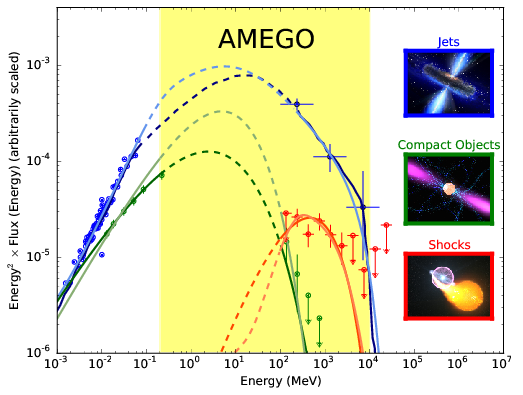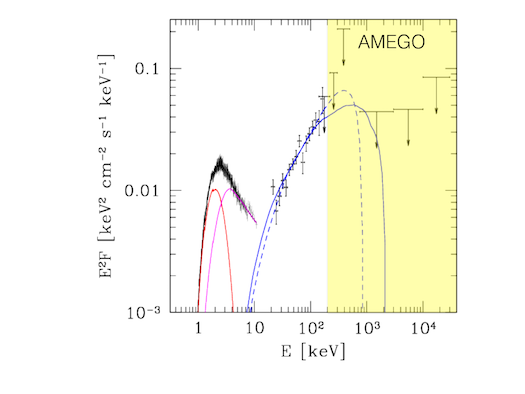Astro 2020 Decadal Review White Papers
Below are the white papers submitted to the Decadal Review that are relevant to AMEGO. These provide a good overview of the science that can be done with an observatory like AMEGO.
AMEGO Mission paper
Multi-Messenger Astronomy and Astrophysics
- Opportunities for Multimessenger Astronomy in the 2020s
- Gamma Rays and Gravitational Waves
- A Summary of Multimessenger Science with Neutron Star Mergers
- Neutrinos, Cosmic Rays and the MeV Band
- Cosmic Rays and Interstellar Medium with Gamma-Ray Observations at MeV Energies
- High-Energy Polarimetry - a new window to probe extreme physics in AGN jets
- Energetic Particles of Cosmic Accelerators I (Galactic Acclerators)
- Energetic Particles of Cosmic Accelerators II (AGNs and GRBs)
- Prompt Emission Polarimetry of Gamma-Ray Bursts
Formation and Evolution of Compact Objects, Cosmology and Fundamental Physics
- Supermassive black holes at high redshifts
- Prospects for AGN Studies at Hard X-ray through MeV Energies
- Magnetars as Astrophysical Laboratories of Extreme Quantum Electrodynamics: The Case for a Compton Telescope
- Prospects for detection of synchrotron halos around middle-age pulsars
- Looking Under a Better Lamppost: MeV-scale Dark Matter Candidates
Stars and Stellar Evolution, Galaxy Evolution
AMEGO Science
The three groundbreaking capabilities of AMEGO continuum sensitivity, nuclear line spectroscopy and polarization combine to address questions in the following key science areas.

Characterizing the medium-energy gamma-ray band is essential to distinguish between spectral models and to understand the mechanism that produce emission from jets, compact objects, and shocks.
Understand the formation, evolution, and acceleration mechanisms in astrophysical jets
Blazars are the most powerful subset of Active Galactic Nuclei (AGN). Their relativistic jets are oriented close to our line of sight and and emission from these jets dominates their broadband emission. In many blazars, known as MeV blazars, the peak energy output is in the AMEGO band. MeV blazars have larger-than-average jet power and accretion luminosity and are often found at very large redshift. They harbor the most massive black holes, with masses exceeding a billion solar masses. MeV blazars are thus powerful probes of the growth of supermassive black holes across the history of the Universe.
AMEGO will offer a unique view into blazars' emission mechanisms. Observations of the poorly explored 0.3-100 MeV energy band with AMEGO will measure their spectral energy distributions and variability with unprecedented sensitivity and link the observed characteristics to crucial physical parameters of these systems, such as the maximum energy to which particles are accelerated, the strength of the magnetic fields, the content of the jet, and the location of the gamma-ray emission site. The polarization measurement capability of AMEGO provides a crucial test of the jet content, because hadronic models predict a much higher degree of polarization than leptonic models.
The detection and characterization of the MeV blazar population is critical to understand black hole formation and growth at high redshift. Its ground- breaking sensitivity and all-sky survey capability ensure that AMEGO will measure the properties of a large sample of MeV blazars.
Identify the physical processes in the extreme conditions around compact objects
In the energy range of AMEGO, important open questions about neutron stars can be resolved. Neutron stars, with their extreme densities, electric potentials, and magnetic fields, display a great variety of observational characteristics and behavior (see Harding et al. 2013 for a review). The relation between the diverse classes of neutron stars, from magnetars to millisecond pulsars, is a decades-old mystery. One of the intriguing puzzles is the connection between the rotation-powered pulsar (RPP) population and the magnetars, magnetically powered neutron stars that undergo violent bursting and whose quiescent emission alone far exceeds their spin-down luminosities. Many RPPs have surface dipole magnetic field strengths inferred from their period and period derivatives that are as high as those of magnetars, and some magnetars have dipole fields lower than many RPPs. What determines their very different behavior? Magnetar quiescent emission consists of a hot thermal component plus a hard non-thermal component with spectra measured by INTEGRAL up to 200 keV ( Kuiper, den Hartog, Hermen 2008) and upper limits from COMPTEL and Fermi indicating a cutoff in the 1-10 MeV range. On the other hand, many RPP spectra have non-thermal emission that extends to GeV energies. Recently PSR J1119-6127, a radio, X-ray and gamma-ray RPP, exhibited a magnetar-like burst (Kennea et al. 2016; Göğüş et al. 2016) that was accompanied by a glitch and a turn-off of the radio (Burgay et al. 2016) and gamma-ray ( Younes et al. 2016) pulsations. Following the burst,the X-ray spectrum developed a hotter thermal component and a hard non-thermal component very similar to the quiescent spectra of magnetars (Archibald et al. 2016). This suggests a strong connection between magnetars and high-magnetic field pulsars and raises the possibility of a continuum between the two neutron star classes, but the nature and cause is still unclear. If the hard X-ray emission is due to cyclotron resonant upscattering by accelerated particles in the near-surface fields ( Baring & Harding 2007; Beloborodov & Thompson 2007) the cutoff energy due to pair production and photon splitting is very sensitive to the magnetic field direction at the emission location (Beloborodov 2013). Measurement of the phase-resolved quiescent spectra of magnetars in the 300 keV to 10 MeV band with AMEGO will determine the high-energy cutoffs, and assess how similar they are to the sub-GeV turnover seen in the high-field transitional RPP PSR J1513-5908 ( Abdo et al. 2010). They will also reveal whether the magnetic field has a significant toroidal component, thought to be a critical characteristic distinguishing magnetars and RPPs. Observation of high magnetic field RPPs following magnetar-like bursts could identify transient toroidal fields and answer the question of whether magnetic field structure distinguishes magnetar vs. RPP behavior.
The high-energy cutoffs in hard spectral components of magnetars are predicted to be highly polarized since pair production and photon splitting cutoffs occur at different energies and attenuate orthogonal emission modes (Baring & Harding 2001). The AMEGO measurements of this unique signature of near 100% polarization near the high-energy cutoff of magnetar quiescent spectra could verify that this emission comes from near the neutron star surface and provide an in situ measurement of a magnetar magnetic field.

AMEGO will have a wide energy band, excellent continuum sensitivity, and the necessary energy resolution needed to resolve open questions in magnetar physics, demonstrated by the spectral energy distribution of magnetar 1RXS J1708-4009 (Hascoët et al. 2014). The solid blue and dashed blue lines show two different models for the shape of the high-energy cutoff.
Measure the properties of element formation in dynamic systems
The creation of "metals" in stars led to the enrichment of gas and stars in the Galaxy to a mass fraction of about 2%. This process of Galactic chemical evolution is driven by the star-formation rate, and the relative rates of various sources of nucleosynthesis occurring in dynamic environments; predominantly thermonuclear (Type Ia) and core-collapse (Type II) Supernovae (SNe).
The chemical evolution processes are traced with spectroscopic abundance measurements in stars and the interstellar medium, where iron (mostly from SN Ia) and oxygen (mostly from SNII) provide a chemical clock. Gamma-ray line astronomy contributes to this study in unique ways: for nearby SNe it is possible to directly measure the freshly synthesized amount of 56Ni,the decay of which keeps SNe bright for much longer than the adiabatic cooling of the eject would otherwise allow. On longer time scales we find 44Ti, which deposits energy on a 100-year time scale, and 26Al and 60Fe, which decay on a million-year time scale.
All these unique tracers of radioactivity produced in SNe reveal their presence via gamma-ray lines in the MeV band probed by AMEGO. The typical yields are of order 10-4 solar masses, so with an event rate of order one per century a steady state mass of radioactive aluminum or iron of order one solar mass is present in the disk of our galaxy. The resulting diffuse gamma-ray line glow of these isotopes has been detected, and in fact allows one of the best Galaxy-wide measurements of the Galactic star-formation rate (averaged over a few million years).
Gamma-ray line observations in the MeV band offer unique opportunities to reveal the multi-source origins of the metal content of our galaxy. It furthermore offers an opportunity to probe the central regions of these explosive sites through the glow of supernova remnants that occurred in the past millennium, or the detection of SNe in the local universe. Particularly important is the potential to detect gamma-ray lines from nearby Type Ia supernova explosions ( Horiuchi and Beacom 2010). AMEGO will detect ~6 SN Ia per year, out to a distance of at least 30 Mpc . The 847 keV line from 56Co decay directly yields the 56Ni mass, which AMEGO will measure precisely for the nearest SNIa events.
This mass is a critical factor determining the SNIa light curves and their use as standardizable candles. Thus AMEGO will open a new window for testing SNIa calibration as distance indicators, and hence as probes of cosmic acceleration. Limited sensitivity in the MeV band prevented significant progress in this arena. With the huge boost from AMEGO's sensitivity relative to COMPTEL and INTEGRAL, the study of the radioactive galaxy will experience a renaissance. We expect to detect more remnants, better map the diffuse lines (including the puzzling 511 keV line), detect explosions in nearby galaxies, and finally detect the long-predicted nuclear lines of CNO atoms excited by Galactic cosmic rays. AMEGO will study isotope production in ways possible only with gamma rays, where nuclear physics reigns and atomic sensitivities to the thermal state of the emitting plasma are minimized. AMEGO will advance all aspects of Astronomy with Radioactivities through its greatly boosted sensitivity.
Test models that predict dark matter signals in the MeV band
The nature of dark matter is crucial to our understanding of the structure and evolution of the Universe after the big bang. AMEGO will be the most sensitive probe in the MeV energy range to gamma- ray signatures to two leading dark matter candidates: Weakly Interacting Massive Particles (WIMPs) and axion like-particles (ALPs). This makes it an ideal instrument for dark matter searches.
WIMP dark matter naturally arises in extensions of the Standard Model of particle physics. Typically WIMPs are thought to have masses > 1 GeV, which produce gamma rays with energies starting in the ~100 MeV range. AMEGO is ideal for searching for low-mass WIMP dark matter with the necessary precision in the MeV range for detection.

AMEGO will detect the absorption features in the gamma-ray spectra from interactions between gamma rays and axions in large magnetic fields. Gamma rays are produced in sources such as AGN (shown) or galaxy clusters, and will interact in the surrounding large magnetic fields. This interaction could cause gamma rays to convert into axions or ALPs and back again to gamma rays, yielding absorption features.
ALPs interacting with photons in the presence of external magnetic fields lead to energy-dependent mixing similar to neutrino oscillations. These oscillations yield distinctive features in the energy spectra of the target observed. Ideal targets have known large magnetic fields, such as magnetars, blazars and galaxy clusters. Gamma rays from these sources often times traverse multiple magnetic-field environments in which gamma rays could convert into an ALP and vice versa. AMEGO is, with its low energy threshold, large field of view, and excellent angular resolution, the perfect instrument to search for such a signal and will extend these searches to ALP masses by orders of magnitude. The sensitivity surpasses that of current and planned dedicated ALP laboratory searches.

